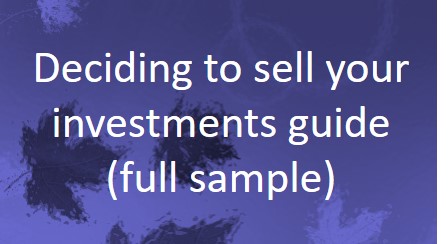Guide to reviewing your investments (full sample)
An example of my editing and proofreading services.
It can be useful to understand exactly how my proofreading and editing services can help you. Below, you’ll find an article that I copy edited and proofread to give you an idea of how I can enhance your content. Please have a read, and if you like the content then please get in touch or get a quote.
About this content
Learn how to review your investments on a quarterly and annual basis by carrying out an investment review. This article shares some best practices that you can use to explore your investments and decide what to do with them. It also covers areas like taxes, fees, and financial goals.
Areas of expertise
How to Review Your Investments
A vital part of investing is reviewing your investments on a regular basis and making changes to your portfolio based on how they are doing. This will help you keep your portfolio in good shape and ensures that you're still working towards your financial goals.
Reviews don't have to be time-consuming or complicated, and simple quarterly and annual reviews are good enough to keep you on track. Here are some simple principles that you can use on a quarterly and annual basis to manage your investments.
Carry out a quarterly review
Every three months, you should look at individual investments and your portfolio and ask the following questions.
How has each of your investments been doing over the last quarter and the last year?
Start by understanding the performance of each of your investments and your overall portfolio. You'll want to look at both capital gains / losses (the change in the purchase price of the investment) and any interim gains or dividends (money that's paid to you over the life of the investment). You can compare these returns to the market and to your financial goals and plans.
Do you need to make any changes to your under-performing investments?
If some of your investments have been under-performing, you might want to explore them in more depth, to understand why they are under-performing. If you're still confident in the investment, it's probably worth holding on to so that it can increase in value over time. If you've lost confidence in the investment, think about reducing your holding or selling it altogether.
Do you need to deal with dividends or other returns on your investments?
If you've received interim payments in your account, it's possible that they have been automatically reinvested. If they haven't, you'll need to decide if you want to withdraw them or reinvest them. In most cases, unless you need the money, it's better to reinvest.
Are you still on track with your financial goals?
Finally, as part of your quarterly review, look at your overall financial goals. Make any small tweaks or changes to your investments to keep you on track.
Carry out a more thorough yearly review
In addition to a quarterly review, it's also worth completing a more thorough annual review. When you're carrying out your annual review, ask yourself the following questions.
Do you understand what your tax burden is likely to be?
You'll probably need to pay taxes on any profit that you make on your investments, whether that's through interim payments or on any capital gains if you sell an investment. Talk to your accountant to learn how much tax you'll need to pay and ensure that you put enough aside to make the payment.
Your tax adviser or accountant can also give you advice on how to minimize your tax burden; for example, you'll normally have to pay a higher rate of tax if you sell an investment less than a year after buying it. It's also important to note that you could offset any losses that you've made against your gains.
Can you reduce the fees that you have to pay on your investments?
You'll often have to pay fees when you invest. Sometimes you'll need to pay them when you buy or sell investments, and sometimes they'll be levied on an annual basis as a "management fee" based on the value of your investments. Review the fees that you've paid over the last year and deduct them from your returns to see the impact they have had.
Go through each of the fees to understand if there are better options or other providers where you can pay lower fees. If there are, consider moving your investments.
Do you need to make any major changes to your portfolio?
Look at your risk profile and financial goals and compare this to your investment performance. See if you need to make changes to your portfolio to keep your likely risks and rewards in your comfort zone, this might involve re-balancing your portfolio by selling some investments and buying others so that you can reduce your risk.
Has an investment performed well enough that you might want to sell it?
If an investment has done well, you might want to consider selling it and realizing the gains. You should generally only do this if you need the money, if you're investing to a specific goal, or if you think you can get a better return elsewhere. Otherwise, continue to hold money in the investment and let it grow more over time.
Remember that if you sell an investment, you may have to pay transaction fees and taxes on any profits that you make.
Getting into the habit of carrying out regular investment reviews will help you meet your financial and life goals. With practice, you can complete each of the reviews in an hour or two. This will be time well spent, as the decisions you make can reduce your risk and make it easier to build your wealth.
Content originally written by Paul Maplesden, a freelance writer, and edited by me.




